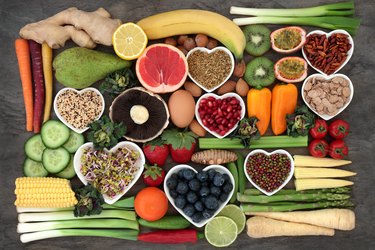
You probably do your best to eat nutritiously. You avoid empty-calorie food choices most of the time; you watch your calories. Still, it can be tough to really know whether or not your day-to-day diet nets you all you actually need. Here, we run down how to size up your nutrition situation.
Macronutrients
Video of the Day
Nutrients are separated into two categories. The first is macronutrients, which are sources of energy that we need a lot of. The three macronutrients are protein, carbohydrates and fat.
Video of the Day
The ideal proportions of macronutrients in the diets of men and women are as follows, according to the 2015-2020 USDA Dietary Guidelines for Americans:
- 45-65 percent of daily calories coming from carbohydrates
- 10-35 percent from protein
- 20-35 percent from fat (less than 10 percent of which should come from saturated fat)
So how many grams of carbs, protein and fat do those percentages translate into? It depends on your daily caloric intake. The USDA's dietary guidelines use 1,800 calories for women and 2,200 for men as the benchmarks, but your personal target calorie intake will depend on your age, how active you are and whether you're looking to lose, maintain or gain weight.
Each gram of protein and carbohydrate has four calories, and each gram of fat has nine. To figure out the number of grams of a macronutrient to consume per day, you first need to know how many calories of that macronutrient you need. That's just a matter of multiplying the recommended percentage by your total number of daily calories. Then divide the result by four or nine.
Micronutrients
Micronutrients is the second category of nutrients. These are also essential parts of our diet, but they are smaller molecules than the macros, and we don't need them in as high a quantity.
Vitamins, both water- and fat-soluble, and minerals are considered micronutrients, according to Washington State University. There are four fat-soluble vitamins (Vitamins A, D, E and K); and nine water-soluble vitamins (the B-complex vitamins and C), per Colorado State University Extension.
Essential minerals number 16, including calcium, phosphorus, potassium, sulfur, sodium, chloride, magnesium, iron, zinc, copper, manganese, iodine, selenium, molybdenum, chromium and fluoride. (Good to know: On food labels, the percent of daily value is based on a 2,000-calorie diet.)
Men and women have different vitamin requirements, with variation also based on age. "Females ages 19 to 50 require more iron than their male counterparts due to increased losses through menstruation. Adult males 19 to 50 years of age, meanwhile, require more of vitamins C, K, B1, B2 and B3, as well as the minerals magnesium, zinc, chromium and manganese," notes Michelle Young, RD, LDN, clinical dietitian at Northwestern Medicine Lake Forest Hospital in Lake Forest, Illinois. She adds: "Vitamin D requirements increase as we age due to the higher risk for age-related bone loss and fracture."
A varied diet that includes fruits, vegetables, fish, lean meats, legumes, nuts and seeds will generally provide adequate intake of micronutrients. "There comes a need for supplementation only when a deficiency is spotted, such as in iron-deficiency anemia, or vitamin B12 or D deficiencies, which are fairly common," says Young. "Here, a supplementation would be necessary in order to correct the deficiency."
That said, it is definitely possible (and desirable) to get all you need from a healthy, varied diet. Filling your plate with an assortment of colorful foods — say, spinach, tomatoes, butternut squash, blueberries — is a great way to start. And if you've ever been tempted to rely on a multivitamin to pick up the slack when you've fallen off the healthy-eating wagon, it isn't that easy. "Multivitamins will not replace a healthy diet, as they lack other beneficial compounds, such as antioxidants, phytonutrients, fiber and essential fatty acids," says Young.
The Bottom Line on Water
"Water is required by the body in amounts that exceed its ability to produce it, so it is also considered an essential nutrient," says Young.
We've all heard the old "Drink at least eight glasses of straight water per day" edict, but do we really need that much? Actually, it depends. "The amount of water someone needs to stay hydrated depends on various factors, such as activity level, exercise intensity, temperature and humidity," explains Young.
One way to calculate your body's fluid needs is to multiply your weight in kilograms (whatever it is in pounds divided by 2.2) by 30. "This gives you an amount to shoot for, in milliliters. If the weather is hot or you're sweating more during your workout, add two to three cups to that amount," says Young.
"One indicator of hydration status is the color of your urine. It should be pale yellow or clear," adds Young. "And don't rely on thirst, because if you feel thirsty, you are already dehydrated."
It's true that caffeine is a diuretic, which is why we're told that caffeinated drinks don't "count" towards our daily water intake. "Actually, though, not all of the fluid contained in a standard cup of coffee is filtered out of the body; some is, in fact, used by the body for hydration. The same goes for some teas and sodas that contain a standard amount of caffeine," says Young.
Ideally, to maintain consistent energy and blood sugar levels, you should eat, if not a meal, at least a snack every three to four hours. Meals and snacks with protein, carbohydrates and fat will keep you full longer and give you longer-lasting energy than carb-heavy fare. Keep in mind that it's always smart to touch base with your physician before changing up your diet.